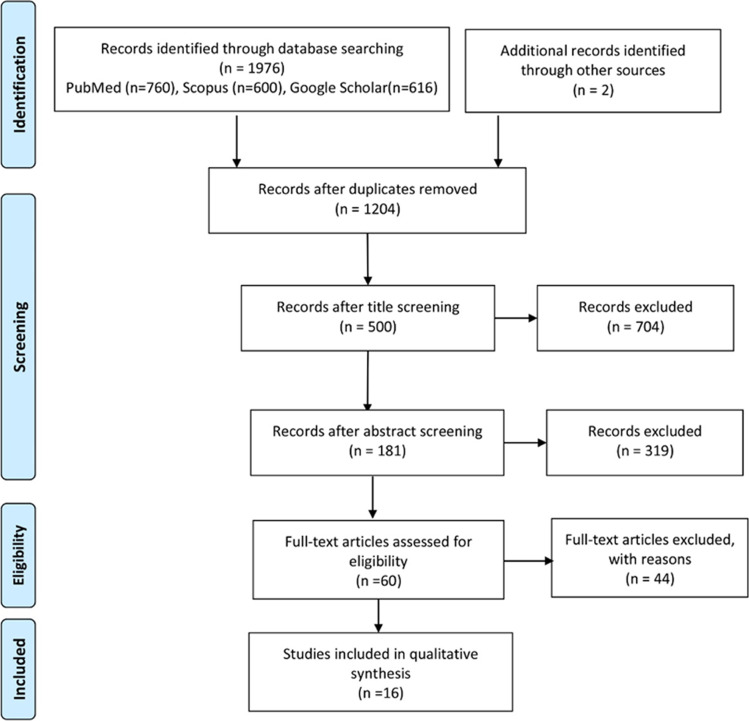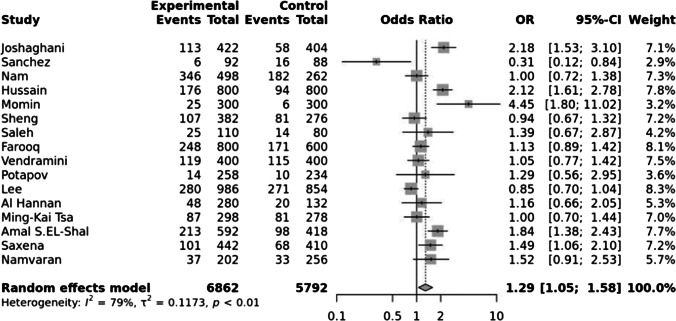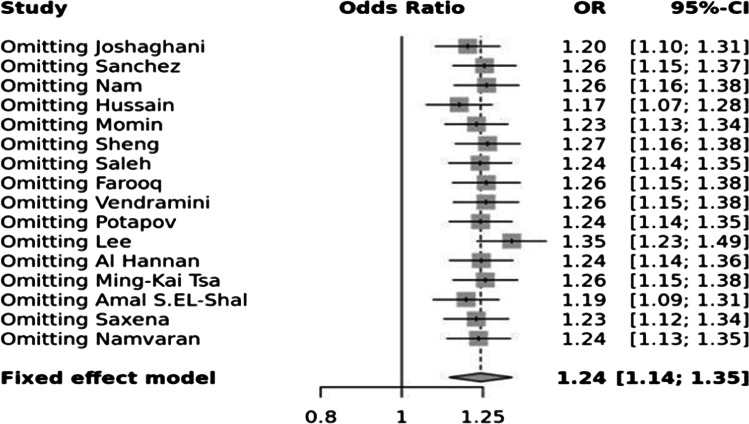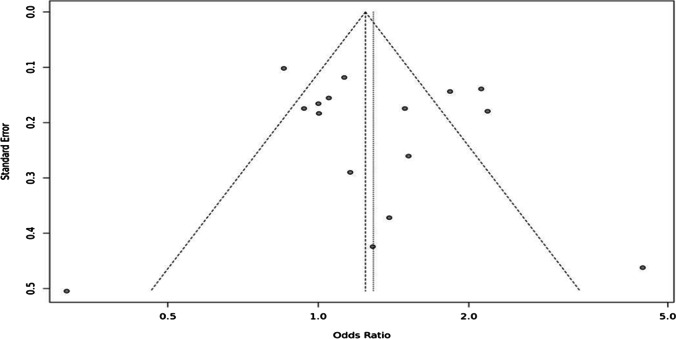Abstract
Objective
There is extensive research on the association between polymorphisms in the adiponectin gene (ADIPOQ) and type 2 diabetes (T2D). The present meta-analytic study explored the association between ADIPOQ rs2241766 polymorphisms and T2D.
Metolds
Articles were collected by searching Google Scholar, Scopus, and PubMed electronic databases until 2021. They were searched using a systematic search of original and sensitive English keywords and their equivalent keywords based on the keywords “type 2 diabetes”, “ADIPOQ”, and “rs2241766”. The article selection criteria were based on the PRISMA (Preferred Reporting Items for Systematic Reviews and Meta-Analyses) flow diagram.
Results
The results revealed that there was no bias in this study. Some studies, such as Joshaghani et al. (odds ratio [OR] = 2.18), Hussain et al. (OR = 2.12), Momin (OR = 4.45), and Amal et al. (OR = 1.84), showed an increasing effect of ADIPOQ rs266729 polymorphism on T2D with 95% CI (P ˂ 0.01), while some have shown no significant association between them.
Conclusion
The results of this meta-analytic study showed the relationship between ADIPOQ and rs2241766. Also, it was found that Rs2241766 polymorphism and allele increase the risk, and rs2241766 increases the risk of developing T2D (OR = 1.29).
Keywords: Type 2 diabetes, Diabetes mellitus, ADIPOQ, rs2241766, Adiponectin gene
Introduction
According to the World Health Organization (WHO), type 2 diabetes (T2D) is a group of metabolic disorders caused by insulin resistance and insulin deficiency and characterized by chronic hyperglycemia and metabolism disorders of carbohydrates, fats, and proteins [1]. It is the most common metabolic disease accounting for 90% of patients with diabetes [1, 2]. Also, T2D is a specific type of insulin resistance in patients. According to WHO, the number of diabetic patients in 2017 was 451 million worldwide. This value is predicted to increase to more than 695 million by 2045 [1, 2]. T2D is a complex disease caused by environmental and genetic factors [3]. Since genes are involved in the causes of cancer, the ADIPOQ gene is also effective in diabetes [4–9].
ADIPOQ is a 30-kDa protein and indicator for estimating adipose tissue dysfunction and systemic inflammation in diabetic patients [4, 10] ADIPOQ is the most abundant cytokine derived from adipose tissue. This protein is present in plasma in 3 forms with low, medium, and high molecular weight, with the third type being biologically active. ADIPOQ binds to 2 receptor subtypes (AdipoR and AdipoR2) and is involved in AMPK metabolism, lipid activation, and insulin action [11, 12]. Many studies have also shown that ADIPOQ polymorphisms are significantly associated with diabetes [13–15]. Besides, research has shown that SNP rs2241766 is directly related to the ADIPOQ protein level [12, 15].
Van et al. found that rs2241766 polymorphisms significantly increased the risk of T2D in an Asian population [16]. Eaton et al. also reported that the rs2241766 allele was significantly associated with a sensitive gene in T2D patients in a Chinese population [17]. However, Han et al. found no association between SNP45 and SNP276 polymorphisms and T2D [18]. Despite considerable findings regarding the association of ADIPOQ polymorphisms with T2D [13, 15], the results of some studies in this area are disappointing [19, 20]. To the best of our knowledge, there are no definite reports and evidence on the relationship between ADIPOQ rs2241766 polymorphisms and T2D in humans or animals. Accordingly, we investigated the relationship between ADIPOQ rs2241766 polymorphisms and T2D. The results of this study can be used in designing treatment methods for diabetes in humans.
Materials and methods
Search strategy
We collected the required data by searching Google Scholar, Scopus, and PubMed databases. To this end, we started with a systematic search of English keywords with all possible compounds, important, main, and sensitive words, and their equivalent keywords. Articles were searched based on the keywords “Diabetes Mellitus, Noninsulin-Dependent” OR “Diabetes Mellitus, Types” AND “adiponectin” OR “ADIPOQ” AND “Polymorphism, Genetic” OR “Polymorphism, Single Nucleotide/genetics” [Mesh] OR “SNP” OR “rs2241766.”
Criteria for selecting articles
After studying all abstracts of the articles, unrelated articles were excluded, possible related articles were identified, and their full texts were extracted. Inclusion criteria were studies in which the intervention was the effect of the rs2241766 polymorphism gene on T2D, studies with a T2D patient group and control group (non-diabetic individuals), and related articles in English. Finally, animal and in vitro studies, meta-analysis and review articles, and clinical articles were excluded from the study.
Statistical analysis
As the selected studies were heterogeneous, a random-effects model was applied to combine them. The Cochran test and I2 index were used to evaluate the heterogeneity of the studies. Also, the collected data were analyzed using STATA software.
Results
Data extraction
Initially, 145 articles published by 2021 were reviewed. Next, the first 1976 articles were imported to EndNote, and 1204 articles remained after removing the duplicate ones. Then, the titles of articles were screened, 500 articles were entered into the study, and 704 articles were removed. After screening the abstracts of the articles, 319 unrelated articles were removed. Finally, 18 articles that met the inclusion criteria were meta-analyzed (Fig. 1). The article selection criterion was based on the PRISMA (Preferred Reporting Items for Systematic Reviews and Meta-Analyses) flow diagram.
Fig. 1.
The process of selecting eligible articles
The number of cases, number of controls, and number of homozygous (AA), heterozygous (GA), and wild (GG) genotypes of the rs2241766 polymorphism gene were examined in cases and controls in each study. The article publication year and the study population were extracted and entered into the form. OR and 95% CI were calculated in each study.
In the heterogeneity test, P values less than 15 were considered statistically significant.
Results
Figure 1 shows the characteristics of 16 identified case studies on ADIPOQ rs2241766 levels and the risk of T2D. The studies conducted by 2020 in Iran, India, Venezuela, South Korea, Iraq, China, Bangladesh, Bahrain, Brazil, and Japan (Fig. 1) were included in this analysis. The results revealed that the studies of Sánchez et al., Joshaghani et al., Hussain et al., Momin, and Amal et al. had a significant difference with a P value less than 0.01. In contrast, other studies did not show a significant difference. The results of Sánchez et al. (OR = 0.31) indicated a decreasing effect on T2D, while the studies of Joshaghani et al. (OR = 2.18), Hussain et al. (OR = 2.12), Momin (OR = 4.45), and Amal et al. (OR = 1.84)) showed an increasing effect on T2D. However, the final overall OR was reported to be 1.29 [1.05; 1.58], which indicates that SNP rs2241766 has an increasing effect on T2D (Fig. 2).
Fig. 2.
Association between rs2241766 gene polymorphism and the risk of T2D
Based on the entered data and the obtained OR values, the chart is stretched to the right, and the overall OR was found to be 1.24 with 95%CI. Therefore, the results showed that SNP rs2241766 increased the risk of T2D. In fact, this gene not only does not reduce the chances of developing the disease but also increases the risk of developing it (Fig. 3).
Fig. 3.
The association of rs2241766 polymorphism with the risk of T2D
The results showed that bias had no effect in this study (P = 0.79), which is shown symmetrically in the funnel chart. The size of the circles indicates the weight of the studies. In other words, the larger circles show greater samples. This chart also shows several cases outside the scope of the study. There was also some evidence of heterogeneity among the studies (I2 = 79%; P = 0.79; Fig. 4).
Fig. 4.
The funnel chart shows publication bias; the rate ratio is shown against the standard error. It is a symmetrical distribution, which indicates a lack of bias
Discussion
Although many studies have shown that ADIPOQ polymorphisms are associated with T2D [13–15], the association of ADIPOQ rs2241766 polymorphisms with T2D is still one of the most challenging issues. Therefore, the present study sought to explore the relationship between ADIPOQ rs2241766 polymorphism and T2D using database search methods. Many basic mechanisms in ADIPOQ polymorphisms are associated with T2D. Several studies have shown significant differences in the risk of developing T2D among individuals with the ADIPOQ genotype [13–15]. In addition, many studies have reported that SNP rs2241766 is directly associated with the ADIPOQ protein level [12, 13, 15]. Previous studies have also reported conflicting results on the association of the ADIPOQ gene with rs2241766 polymorphism and the risk of T2D [18].
Therefore, this meta-analytic study was designed to determine whether the ADIPOQ gene is associated with the risk of T2D in studied populations. Overall, the studies of Sánchez et al., Joshaghani et al., Hussain et al., Momin, and Amal et al. showed an increasing effect between ADIPOQ polymorphism genotypes and T2D. This finding was consistent with the one reported by Amal et al. (2014), which used the PCR-RFLP method to investigate the association of ADIPOQ polymorphism genotypes with T2D. This study showed that both TG and GG genotypes increased significantly in diabetic patients, and the mean OR was reported to be 1.5 [21]. In another effort, Eaton et al. also conducted a study using the PCR method. According to this research, the rs2241766 allele was significantly associated with a sensitive gene in T2D patients in a Chinese population [17]. Hussain et al. (2018) used the PCR-RFLP method to investigate the association between ADIPOQ polymorphism genotypes and T2D. They found that the genotypic distribution of rs2241766 had a significant increase in homozygous GG (OR = 5.04) and heterozygous TG carriers (OR = 1.7). It was also reported that the rs2241766T > G SNP of the ADIPOQ gene was a risk factor for developing T2D in an Iraqi population [22]. Joshaghani et al. (2020) also conducted a study using the PCR-RFLP method to investigate the association between the ADIPOQ polymorphism genotypes and T2D in an Iranian population. They found that the G allele and GG and TG genotypes were more abundant than the T allele and TT genotype in T2D patients compared with the control group. G/T SNP was also shown to be associated with T2D. Furthermore, there was also a statistically significant difference in the frequency of the G/T allele and genotype between the control group and diabetic patients [23]. Saxena et al. (2012) investigated the association between ADIPOQ polymorphism genotypes and T2D in an Indian population using the PCR-RFLP method. They found a significant relationship between the G allele of the ADIPOQ gene and T2D patients compared with the control group [24]. Elsewhere, using the PCR-RFLP method, Sánchez et al. (2019) investigated the relationship between ADIPOQ polymorphisms and T2D in a Venezuelan population. They found that genotypes with heterozygous T/G and G/G homozygous polymorphism were more frequent in the diabetic group than in the control group [25]. However, Hannan et al. found that SNP45 and SNP276 polymorphisms are not associated with T2D [18] (Table 1).
Table 1.
Characteristics of included studies selected for meta-analysis
| Author. | Year of Publication | Population | Method | Cases (n) | Controls (n) | Overall Sample Size | Count (Genotype) | |||||
|---|---|---|---|---|---|---|---|---|---|---|---|---|
| Diabetic | Nondiabetic (Control) | |||||||||||
| GG | TG | TT | GG | TG | TT | |||||||
| Joshaghani et al. | 2020 | Iranian | PCR-RFLP | 211 | 202 | 413 | 18 | 77 | 116 | 5 | 48 | 149 |
| Sánchez et al. | 2019 | Venezuelan | PCR-RFLP | 46 | 44 | 90 | 1 | 4 | 41 | 2 | 12 | 30 |
| Nam JS | 2018 | Korean | PCR | 249 | 131 | 380 | 119 | 108 | 22 | 61 | 60 | 10 |
| Hussain et al. | 2018 | Iraqi | PCR-RFLP | 400 | 400 | 800 | 33 | 110 | 257 | 8 | 78 | 314 |
| Momin AA | 2017 | Indian | PCR | 150 | 150 | 300 | 2 | 21 | 127 | 0 | 6 | 144 |
| Sheng T | 2016 | Korean Chinese | PCR | 191 | 138 | 329 | 13 | 81 | 97 | 9 | 63 | 66 |
| Saleh R | 2016 | Bangladeshi | PCR-RFLP | 55 | 40 | 95 | 3 | 19 | 33 | 1 | 12 | 27 |
| Farooq,R | 2018 | Indian | PCR-RFLP | 400 | 300 | 700 | 40 | 168 | 192 | 24 | 123 | 153 |
| Vendramini, M.F. | 2010 | Japanese Brazilians | PCR | 200 | 200 | 400 | 12 | 95 | 93 | 15 | 85 | 100 |
| Potapov,V.A. | 2008 | Russian | PCR | 129 | 117 | 246 | 2 | 10 | 117 | 1 | 8 | 108 |
| Lee,Y.Y. | 2005 | Korean | PCR | 493 | 427 | 920 | 39 | 202 | 252 | 45 | 181 | 201 |
| Al Hannan, F.A. | 2016 | Bahraini | PCR-RFLP | 140 | 66 | 206 | 8 | 32 | 100 | 10 | 0 | 56 |
| Ming-Kai Tsa | 2014 | Taiwan’s Chinese Han | PCR | 149 | 139 | 288 | 9 | 69 | 71 | 12 | 57 | 70 |
| Amal et al. | 2014 | Egyptian | PCR-RFLP | 296 | 209 | 505 | 34 | 145 | 117 | 10 | 78 | 121 |
| Saxena et al. | 2012 | North Indian | PCR-RFLP | 221 | 205 | 426 | 23 | 55 | 143 | 11 | 46 | 148 |
| Fatemeh Namvaran | 2012 | Iranian | PCR | 101 | 128 | 229 | 3 | 31 | 67 | 6 | 21 | 101 |
A limitation of this meta-analytic study was that our search was restricted to studies published in English. Thus, it may potentially lead to publication bias. Given the significant heterogeneity among the studies, the present study’s findings should be interpreted cautiously. Finally, the number of studies for subgroup analysis was relatively small. Therefore, further studies are needed to identify the exact association between SNP rs2241766 and the increased risk of developing T2D.
Conclusion
The results of this meta-analysis show the association between ADIPOQ and rs2241766. Rs2241766 polymorphism and allele increase the risk of T2D. Also, rs2241766 with an OR of 1.29 has an increasing effect on T2D and increases the risk of developing it.
Author contributions
Dr. Elham Afraz, Dr. Sanaz Pashapour, Yeganeh Hamidi, and Sahar Saki conducted the research, collected the data, and performed the statistical analysis. Dr. Sanaz Pashapour collaborated in writing and reviewing the processes.
Data availability
The raw/processed data required to reproduce these findings cannot be shared at this time due to legal or ethical reasons.
Declarations
Conflict of interest
The authors state that there is no conflict of interests regarding the publication of this article.
Footnotes
Publisher’s note
Springer Nature remains neutral with regard to jurisdictional claims in published maps and institutional affiliations.
Change history
2/3/2023
Article has been corrected
Contributor Information
Yeganeh Hamidi, Email: hamidiyegane92@gmail.com.
Sahar Saki, Email: Sahar.saki72@gmail.com.
Elham Sadat Afraz, Email: Eafraz75@gmail.com.
Sanaz Pashapour, Email: pashapour.sanaz@yahoo.com.
References
- 1.Cho N, et al. IDF diabetes atlas: global estimates of diabetes prevalence for 2017 and projections for 2045. Diabetes Res Clin Pract. 2018;138:271–281. doi: 10.1016/j.diabres.2018.02.023. [DOI] [PubMed] [Google Scholar]
- 2.Marín-Peñalver JJ, et al. Update on the treatment of type 2 diabetes mellitus. World J Diabetes. 2016;7(17):354. doi: 10.4239/wjd.v7.i17.354. [DOI] [PMC free article] [PubMed] [Google Scholar]
- 3.Abuhendi N, et al. Genetic polymorphisms associated with type 2 diabetes in the Arab world: a systematic review and meta-analysis. Diabetes Res Clin Pract. 2019;151:198–208. doi: 10.1016/j.diabres.2019.03.037. [DOI] [PubMed] [Google Scholar]
- 4.Wdowiak A, Farahmandlou N, Tajik A, et al. The cytotoxic effect of estradiol Valerate, progesterone, and testosterone on brain glioblastoma (A172), colorectal Cancer (HT29) and human embryonic kidney (HEK293) cells and the expression levels of Bax, Bcl-2, and KAI-1/CD82 in A172 and HT29 cells. J B S. 2021;4(3):106–119. [Google Scholar]
- 5.Norouzi S, Ahmadi R, Pashapour S. The cytotoxic effects of Tolmetin on evaluation of Bax and Bcl2 genes expression level in cervical cancer cells (Hela) KAUMS J (FEYZ) 2020;24(1):31–37. [Google Scholar]
- 6.Pashapour S, Heshmati M, Mousavi Z, et al. The apoptotic effect of Methanolic extract of Galium verum on HT29 cell line. J B S. 2022;4(4):210–220. [Google Scholar]
- 7.Pashapour S, Heshmati M, Mousavi Z, et al. The cytotoxicity of the chloroform and petroleum ether fractional extracts of Galium verum L. in HepG2 and HT29 cell lines. J Kerm Uni Medi Sci. 2020;24:e101079. doi: 10.5812/jkums.101079. [DOI] [Google Scholar]
- 8.Pashapour S, Heshmati M, Mousavi Z, et al. Effect of whole methanolic extract of Galium verum on AGO cell line. Toxicol Commun. 2022;4(2):1–10. doi: 10.53388/20220202010. [DOI] [Google Scholar]
- 9.Pashapour S, Heshmati M, Mousavi Z, et al. The effects of methanolic extract of the aerial parts of Galium verum on HT29 and AGO cell lines. Nucleus. 2021:1–10. 10.1007/s13237-021-00380-1.
- 10.Ahmadi H, et al. Effects of eight weeks of aerobic exercise on leptin to adiponectin ratio and glycemic control indices in men with type 2 diabetes. Sport Physiology. 2021.
- 11.Antuna-Puente B, et al. Adipokines: the missing link between insulin resistance and obesity. Diabetes Metab. 2008;34(1):2–11. doi: 10.1016/j.diabet.2007.09.004. [DOI] [PubMed] [Google Scholar]
- 12.Li P, et al. An updated meta-analysis of the association between ADIPOQ rs2241766 polymorphism and colorectal cancer. Tumor Biol. 2014;35(3):2491–2496. doi: 10.1007/s13277-013-1329-3. [DOI] [PubMed] [Google Scholar]
- 13.Pawlik A, et al. Adiponectin and leptin gene polymorphisms in women with gestational diabetes mellitus. J Assist Reprod Genet. 2017;34(4):511–516. doi: 10.1007/s10815-016-0866-2. [DOI] [PMC free article] [PubMed] [Google Scholar]
- 14.Nezamzadeh F, et al. Link between single nucleotide polymorphism of rs266729 and rs2241766 in the ADIPOQ gene and gestational diabetes in an Iranian population. Gene Reports. 2019:1472–5.
- 15.Tu Y, et al. Assessment of type 2 diabetes risk conferred by SNPs rs2241766 and rs1501299 in the ADIPOQ gene, a case/control study combined with meta-analyses. Mol Cell Endocrinol. 2014;396(1–2):1–9. doi: 10.1016/j.mce.2014.08.006. [DOI] [PubMed] [Google Scholar]
- 16.van den Toren SJ, et al. School absenteeism, health-related quality of life [HRQOL] and happiness among young adults aged 16–26 years. Int J Environ Res Public Health. 2019;16(18):321. doi: 10.3390/ijerph16183321. [DOI] [PMC free article] [PubMed] [Google Scholar]
- 17.Eaton SL, et al. Total protein analysis as a reliable loading control for quantitative fluorescent Western blotting. PLoS One. 2013;8(8):e72457. doi: 10.1371/journal.pone.0072457. [DOI] [PMC free article] [PubMed] [Google Scholar]
- 18.Han L, et al. Associations between single-nucleotide polymorphisms (+ 45T> G,+ 276G> T,− 11377C> G,− 11391G> A) of adiponectin gene and type 2 diabetes mellitus: a systematic review and meta-analysis. Diabetologia. 2011;54(9):2303–2314. doi: 10.1007/s00125-011-2202-9. [DOI] [PubMed] [Google Scholar]
- 19.Ling H, et al. Genome‐wide linkage and association analyses to identify genes influencing adiponectin levels: the GEMS stud. Obesity. 2009;17(4):737–744. doi: 10.1038/oby.2008.625. [DOI] [PMC free article] [PubMed] [Google Scholar]
- 20.Heid IM, et al. Clear detection of ADIPOQ locus as the major gene for plasma adiponectin: results of genome-wide association analyses including 4659 European individuals. Atherosclerosis. 2010;208(2):12–420. doi: 10.1016/j.atherosclerosis.2009.11.035. [DOI] [PMC free article] [PubMed] [Google Scholar]
- 21.El-Shal AS, Zidan HE, Rashad NM. Adiponectin gene polymorphisms in Egyptian type 2 diabetes mellitus patients with and without diabetic nephropathy. Mol Biol Rep. 2014;41(4):2287–2298. doi: 10.1007/s11033-014-3082-0. [DOI] [PubMed] [Google Scholar]
- 22.Hussain MK, et al. Adiponectin gene polymorphisms as a predictor for development of type 2 diabetes mellitus in Iraqi population. Gene. 2018;662:118–122. doi: 10.1016/j.gene.2018.03.087. [DOI] [PubMed] [Google Scholar]
- 23.Joshaghani HR, et al. Association of adiponectin gene polymorphisms and their haplotypes with type 2 diabetes and related metabolic traits in an Iranian population. Int J Diabetes Develop Countries. 2020;40(2):216–222. doi: 10.1007/s13410-019-00785-4. [DOI] [Google Scholar]
- 24.Saxena M, Srivastava N, Banerjee M. Genetic association of adiponectin gene polymorphisms (+ 45T/G and+ 10211T/G) with type 2 diabetes in north Indians. Diabetes Metab Syndr: Clin Res Rev. 2012;6(2):65–69. doi: 10.1016/j.dsx.2012.08.008. [DOI] [PubMed] [Google Scholar]
- 25.Sánchez MP, et al. Association between+ 45T> G adiponectin polymorphism gene and type 2 diabetes mellitus and metabolic syndrome in a Venezuelan population. F1000Research. 2019;8(292). 10.12688/f1000research.16890.1. [DOI] [PMC free article] [PubMed]
Associated Data
This section collects any data citations, data availability statements, or supplementary materials included in this article.
Data Availability Statement
The raw/processed data required to reproduce these findings cannot be shared at this time due to legal or ethical reasons.






